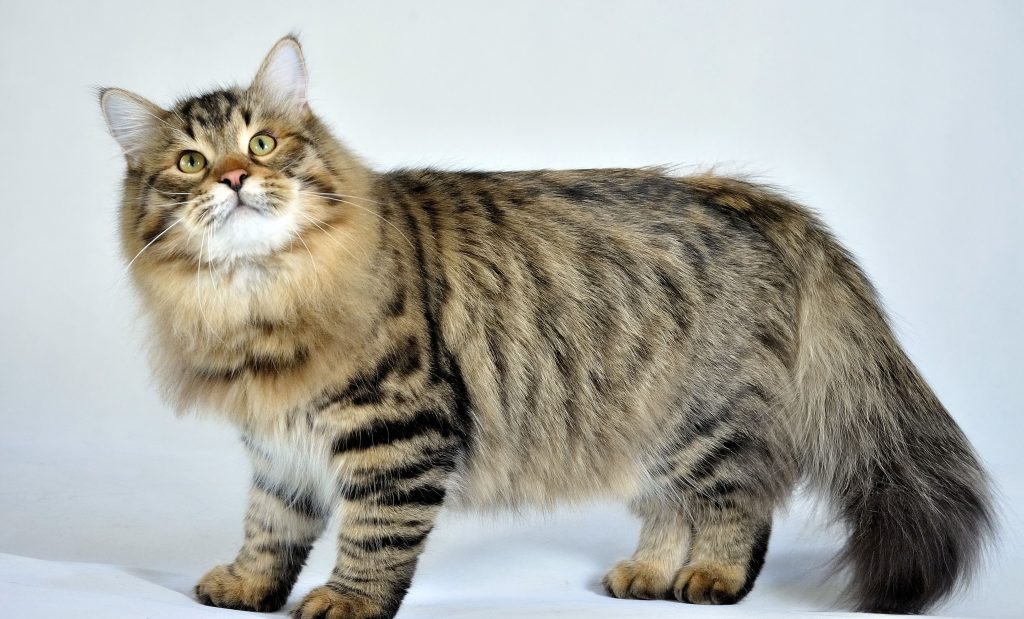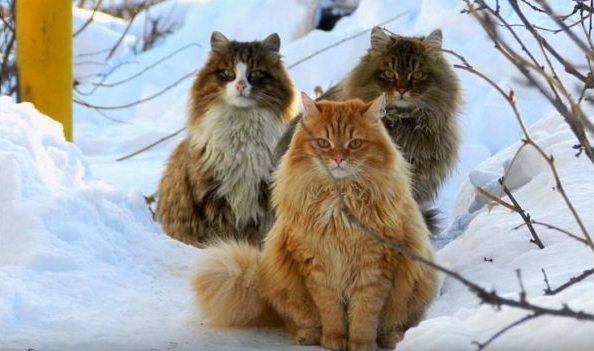The Siberian forest cat is an old natural variety of domestic cats in Russia. The Siberian forest cat breed is considered an ancient cat breed that is ancestral to all modern long hair cats. They have many similarities with the Norwegian forest cat. It originates from Serbia, a natural breed and national cat in Russia. The Siberian Forest cat is a medium to large, strong layers coat with remarkable heft for its size. They are Friendly in behavior with a sweet facial expression.
Let’s get started to know further about the breed of Siberian forest cat.

Table Of Contents
Personality Of Siberian Forest Cat Breed:
The Siberians are adorable cats with a good drench of personality and playfulness. These are very intelligent and smart cat breeds that can solve the problem to get what they want. These cats like to play in the water, as they drop toys in water, or bathtubs before they dry. They are very agile and termed as good jumpers.
They Love their owners and also need special attention, love, and care in return. They are more talkative or express their views as quiet meows, trills, chirps, and motorboat-type purring. They like sitting on your lap while they’re being groomed, an activity they particularly enjoy. Another favorite game is bringing a toy for you to throw again and again— and again. They love all types of toys— and will make a toy out of just about anything. Nature shows on TV with chirping birds or squeaking mice will bring your Siberians running; they’ll put gentle feet on the screen and try to catch the fluttering images.
Because of his legacy as a forest dweller, he likes playing with water, perhaps it’s a genetic memory of going fishing for his supper. Don’t be astonished if your cat enjoys splashing you in the tub, drinking from a fountain or faucet, or making puddles by batting his paw in his water dish. As befits a working and hunting cat, he’s highly athletic, and you may find him balancing atop a doorway or propelling himself to the highest point in the room. Siberian coaches may well be the secret to the success of Russian gymnasts.
Activity and noise won’t bother him a bit. His calm nature gives him the potential to be a therapy cat. If nothing else, he will be happy to snuggle with you when you’re down with a cold or other illness. And although he loves attention, he’s not needy and will wait patiently until you have time to devote to him.
Siberian Forest Cat Physical Characteristics:

Body:
Their body is medium in length, and well-muscled with the back arched slightly higher than the shoulders. The modest stomach pad on the lower abdomen is acceptable.
Size:
This cat typically weighs 8 to 17 pounds and sometimes more.
Head:
An altered wedge of medium size with adjusted shapes, to a great extent to the body. The head is more extensive at the skull’s highest point and limits somewhat to a full-adjusted muzzle. The cheekbones are neither high set nor noticeable. There should be a slight doming between the ears and a practical level region on the temple. The jawline is balanced, however, not projecting and is following the nose.
The muzzle is reasonably short, long, full, and adjusted. There is a slight muzzle arch, yet the change between the side of the head and the muzzle is delicate and subtle. The head’s top is practically level, with a slight nose arch of a slight slant from the temple to the nose and a slight inward ebb and flow before the tip when seen in profile. Neck adjusted, durable, and all-around ripped.
Ears:
Medium-enormous, adjusted, wide at the base, and tilt somewhat forward. The ears should be set as much on the sides of the head as on top. The hair over the rear of the ear is short and slim. From the center of the ear, the goods become longer and cover the base of the ear. Ear tipping is permitted.
Eyes:
Medium to enormous, practically round. The external corner is calculated somewhat towards the base of the ear. The eyes should be separated more than one eye’s width and be open, alert, and expressive. There is no connection between eye tone and coat/shading design aside from the shading focus, which has blue eyes. Eye tone should be shades of green, gold, green-gold, or copper. White felines and felines with white may have blue or odd eyes.
Legs and Paws:
Legs medium long. The legs ought to have considerable boning with the rear legs marginally more extended than the front legs. Feet are large and adjusted, with toe tufts alluring.
Tail:
Medium-long is to some degree more limited than the length of the body. It ought to be wide at the base, tightening somewhat to a dull tip without thickening or crimps, equitably and thickly outfitted.
Shading:
All tones and mixes are acknowledged with or without white. White is permitted in any sum and in all regions. White or grayish permitted on jawline, bosom, and stomach of dark-striped cats. Catches, spots, and mementos are permitted. Solid tones and clear examples are attractive. Discoloring on silvers is not punished.
Health
Both pedigreed felines and blended variety felines have changing rates of medical conditions that might be hereditary in nature. Siberians are commonly solid, yet one issue that has been found in the variety is hypertrophic cardiomyopathy.
Hypertrophic cardiomyopathy is a type of coronary illness that causes the heart muscle to grow. It is found in pedigreed and non-pedigreed felines. Siberians are one of the varieties that might be influenced by this illness.
Care
The Siberian’s thick triple coat ought to be brushed or brushed several times each week to forestall tangles or tangles. The coat will shed occasionally in the spring and fall, and you may need to prep all the more oftentimes during that time. A shower is once in a while fundamental, which is something worth being thankful for on the grounds that the coat is profoundly water-safe. It very well may be hard to get a Siberian wet enough to cleanse him.
Brush the teeth to forestall periodontal sickness. Day-by-day dental cleanliness is ideal, however week by week brushing is superior to nothing. Trim the nails each couple of weeks. Wipe the edges of the eyes with a delicate, sodden material to eliminate any release. Utilize a different territory of the fabric for each eye so you don’t risk spreading any disease.
Check the ears week by week. On the off chance that they look filthy, clear them out with a cotton ball or delicate moist material soaked with a 50-50 combination of juice vinegar and warm water. Try not to utilize q-tips, which can harm the inside of the ear.
The vast majority of the Siberian’s development happens in his first eighteen months of life. Your cat’s raiser may suggest that you feed him cat food during that chance to ensure he gets enough sustenance.
Keep the litter box perfectly spotless. Felines are specific about washroom cleanliness, and a spotless litter box will likewise assist with keeping the long coat clean.
It’s a smart thought to keep a Siberian as an indoor-just feline to shield him from sicknesses spread by different felines, assaults by canines or coyotes, and different risks that face felines who go outside, for example, being hit by a vehicle. Siberians who go outside additionally risk being taken by somebody who might want to have such a lovely feline without paying for it. On the off chance that conceivable, form your Siberian a huge outside nook where he can bounce and climb securely.
Coat Color and Grooming
The Siberian is outstanding for having a long triple coat with monitor hairs (the external coat), awn hairs (the centerpiece of the coat), and a wool undercoat. He has a bountiful ruff around the neck, thick however marginally more limited hair on the shoulder bones and lower part of the chest, and thick hide on the stomach and britches (the upper rear legs). The undercoat thickens in a chilly climate. The coat comes in all tones and blends of tones, with or without white.
He looks incredible and alert, however, looks out at the world with a sweet articulation. His head is a changed wedge with adjusted forms—wide at the top and narrowing somewhat at the gag. Medium-huge ears are all around outfitted with tufts of hiding. The almost round eyes can be green, gold, green-gold, or copper. White Siberians or Siberians with white patches may have blue or odd eyes.
The “weighty, robust, strong” motto might have been composed in light of the Siberian. This is a medium-size to huge feline gauging 8 to 17 pounds and here and there additional. It can take the Siberian as long as five years to arrive at his full size and coat. His body is strong and he has enormous round paws with tufts of hiding and a thickly furred tail.
Decently long to longhaired feline with a triple coat. The hair on the shoulder bones and lower some portion of the chest should be thick and somewhat more limited. Plentiful full collar ruff setting off the head in grown-ups. Take into consideration warm climate coats. The hair may thicken to twists on the paunch and britches, yet a wavy coat isn’t trademark. Surface shifts from coarse to delicate, changing as per shading. There is a tight undercoat (in develop felines), thicker in chilly climates.
Children and Other Pets
The Siberian forest cat has a striking demeanor, and not a lot unsettles his poise. These qualities make him an incredible choice for a family with kids. No evening time beasts will move beyond the Siberian careful at the foot of a kid’s bed. He is glad to live with different felines and feline well-disposed canines, as well, as long as they perceive that he’s in control. Present pets gradually and in controlled conditions to guarantee that they figure out how to get along together.
Final Words
All you need to know about the Siberian forest cat breed is well-explained in this article. We have written a detailed article about this specific breed of cat that gives a piece of detailed information about this cat like; color, eyes, tail, care, and much more. All the facts you needed to know about this type of cat are presented to you.
